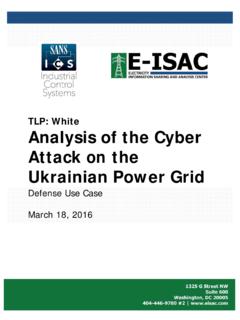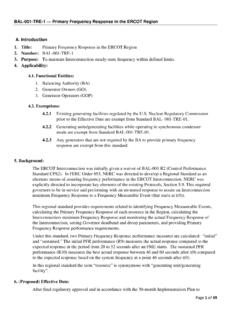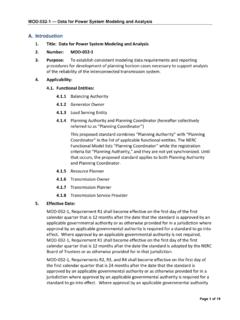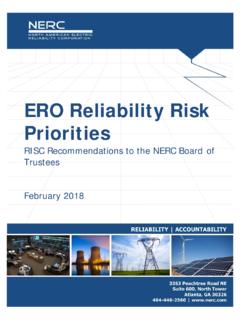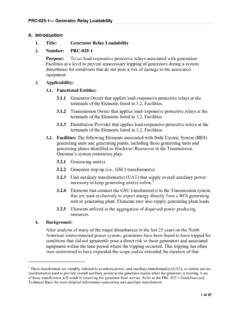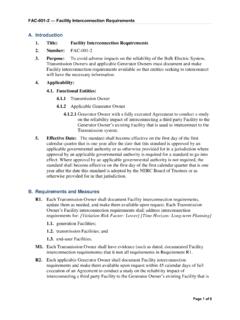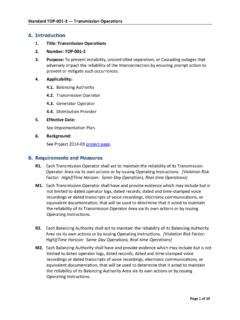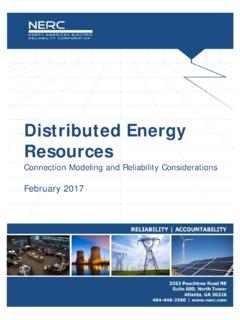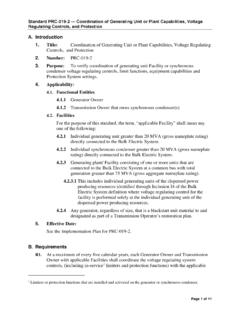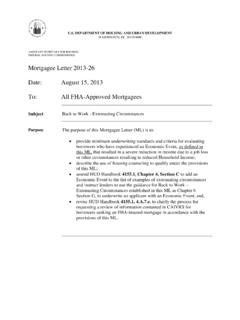Transcription of Glossary of Terms Used in NERC Reliability Standards
1 Glossary of Terms Used in NERC Reliability StandardsUpdated July 3, 2018 This Glossary lists each term that was defined for use in one or more of NERC s continent-wide or Regional Reliability Standards and adopted by the NERC Board of Trustees from February 8, 2005 through July 3, reference is divided into four sections, and each section is organized in alphabetical to EnforcementPending EnforcementRetired TermsRegional DefinitionsThe first three sections identify all Terms that have been adopted by the NERC Board of Trustees for use in continent-wide Standards ; the Regional definitions section identifies all Terms that have been adopted by the NERC Board of Trustees for use in regional Standards . Most of the Terms identified in this Glossary were adopted as part of the development of NERC s initial set of Reliability Standards , called the Version 0 Standards .
2 Subsequent to the development of Version 0 Standards , new definitions have been developed and approved following NERC s Reliability Standards Development Process, and added to this Glossary following board adoption, with the FERC effective date added following a final Order approving the comments regarding this Glossary should be reported to the following: with " Glossary Comment" in the subject TermLink to Project PageAcronymBOT Adoption DateFERC Approval DateEffective Date DefinitionActual Frequency (FA)Project Phase 22/11/20167/1/2016 The Interconnection frequency measured in Hertz (Hz).Actual Net Interchange (NIA)Project Phase 22/11/20167/1/2016 The algebraic sum of actual megawatt transfers across all Tie Lines, including Pseudo-Ties, to and from all Adjacent Balancing Authority areas within the same Interconnection.
3 Actual megawatt transfers on asynchronous DC tie lines that are directly connected to another Interconnection are excluded from Actual Net 0 Reliability Standards2/8/20053/16/2007 The ability of the electric system to supply the aggregate electrical demand and energy requirements of the end-use customers at all times, taking into account scheduled and reasonably expected unscheduled outages of system Balancing AuthorityProject 2008-122/6/20146/30/201410/1/2014A Balancing Authority whose Balancing Authority Area is interconnected with another Balancing Authority Area either directly or via a multi-party agreement or transmission tariff. Adverse Reliability ImpactCoordinate Operations2/7/20063/16/2007 The impact of an event that results in frequency-related instability; unplanned tripping of load or generation; or uncontrolled separation or cascading outages that affects a widespread area of the Interconnection.
4 After the FactProject 2007-14 ATF10/29/200812/17/2009A time classification assigned to an RFI when the submittal time is greater than one hour after the start time of the RFI. AgreementVersion 0 Reliability Standards2/8/20053/16/2007A contract or arrangement, either written or verbal and sometimes enforceable by Interpersonal CommunicationProject 2006-0611/7/20124/16/201510/1/2015 Any Interpersonal Communication that is able to serve as a substitute for, and does not utilize the same infrastructure (medium) as, Interpersonal Communication used for day-to-day Correction FactorProject 2007-072/7/20063/16/2007A multiplier applied to specify distances, which adjusts the distances to account for the change in relative air density (RAD) due to altitude from the RAD used to determine the specified distance.
5 Altitude correction factors apply to both minimum worker approach distances and to minimum vegetation clearance ServiceVersion 0 Reliability Standards2/8/20053/16/2007 Those services that are necessary to support the transmission of capacity and energy from resources to loads while maintaining reliable operation of the Transmission Service Provider's transmission system in accordance with good utility practice. (From FERC order 888-A.)Anti-Aliasing FilterVersion 0 Reliability Standards2/8/20053/16/2007An analog filter installed at a metering point to remove the high frequency components of the signal over the AGC sample Control ErrorVersion 0 Reliability StandardsACE12/19/201210/16/20134/1/2014 The instantaneous difference between a Balancing Authority s net actual and scheduled interchange, taking into account the effects of Frequency Bias, correction for meter error, and Automatic Time Error Correction (ATEC), if operating in the ATEC mode.
6 ATEC is only applicable to Balancing Authorities in the Western Interconnection. SUBJECT TO ENFORCEMENTC ontinent-wide TermLink to Project PageAcronymBOT Adoption DateFERC Approval DateEffective Date Definition SUBJECT TO ENFORCEMENTArea Interchange MethodologyProject 2006-078/22/200811/24/2009 The Area Interchange methodology is characterized by determination of incremental transfer capability via simulation, from which Total Transfer Capability (TTC) can be mathematically derived. Capacity Benefit Margin, Transmission Reliability Margin, and Existing Transmission Commitments are subtracted from the TTC, and Postbacks and counterflows are added, to derive Available Transfer Capability.
7 Under the Area Interchange Methodology, TTC results are generally reported on an area to area InterchangeProject 2008-122/6/20146/30/201410/1/2014 The state where a Request for Interchange (initial or revised) has been submitted for approval. Attaining Balancing AuthorityProject 2008-122/6/20146/30/201410/1/2014A Balancing Authority bringing generation or load into its effective control boundaries through a Dynamic Transfer from the Native Balancing Authority. Automatic Generation ControlVersion 0 Reliability StandardsAGC2/8/20053/16/2007 Equipment that automatically adjusts generation in a Balancing Authority Area from a central location to maintain the Balancing Authority s interchange schedule plus Frequency Bias. AGC may also accommodate automatic inadvertent payback and time error Time Error Correction (IATEC)continued Phase 22/11/20167/1/2016 The addition of a component to the ACE equation for the Western Interconnection that modifies the control point for the purpose of continuously paying back Primary Inadvertent Interchange to correct accumulated time error.
8 Automatic Time Error Correction is only applicable in the Western Interconnection. when operating in Automatic Time error correction absolute value of IATEC shall not exceed Lmax. IATEC shall be zero when operating in any other AGC mode. Lmax is the maximum value allowed for IATEC set by each BA between *|Bi| and L10, *|Bi| Lmax L10 . L10 = 10 is a constant derived from the targeted frequency bound. It is the targeted root-mean-square (RMS) value of ten-minute average frequency error based on frequency performance over a given year. The bound, 10, is the same for every Balancing Authority Area within an Interconnection. Automatic Time Error Correction (IATEC)Project Phase 22/11/20167/1/2016 Y = Bi / BS.
9 H = Number of hours used to payback primary inadvertent interchange energy. The value of H is set to = Frequency Bias Setting for the Balancing Authority Area (MW / Hz). BS = Sum of the minimum Frequency Bias Settings for the Interconnection (MW / Hz). Primary Inadvertent Interchange (PIIhourly) is (1-Y) * (IIactual - Bi * TE/6) IIactual is the hourly Inadvertent Interchange for the last hour. TE is the hourly change in system Time Error as distributed by the Interconnection time monitor,where: TE = TEend hour TEbegin hour TDadj (t)*(TEoffset)Continent-wide TermLink to Project PageAcronymBOT Adoption DateFERC Approval DateEffective Date Definition SUBJECT TO ENFORCEMENTA utomatic Time Error Correction (IATEC)Project Phase 22/11/20167/1/2016 TDadj is the Reliability Coordinator adjustment for differences with Interconnection time monitor control center clocks.
10 T is the number of minutes of manual Time Error Correction that occurred during the hour. TEoffset is or + or PIIaccum is the Balancing Authority Area s accumulated PIIhourly in MWh. An On-Peak and Off-Peak accumulation accounting is required, where:Available Flowgate CapabilityProject 2006-07 AFC8/22/200811/24/2009A measure of the flow capability remaining on a Flowgate for further commercial activity over and above already committed uses. It is defined as TFC less Existing Transmission Commitments (ETC), less a Capacity Benefit Margin, less a Transmission Reliability Margin, plus Postbacks, and plus Transfer CapabilityProject 2006-07 ATC8/22/200811/24/2009A measure of the transfer capability remaining in the physical transmission network for further commercial activity over and above already committed uses.
